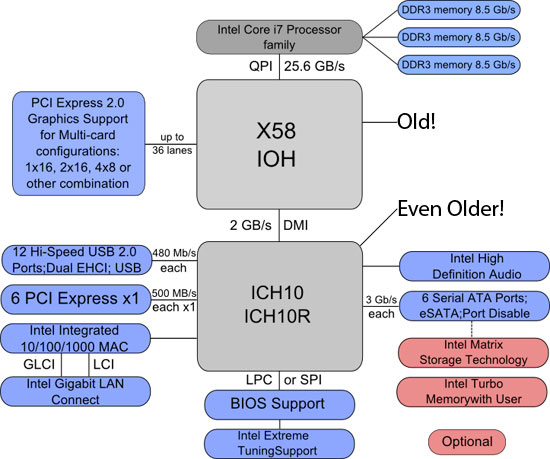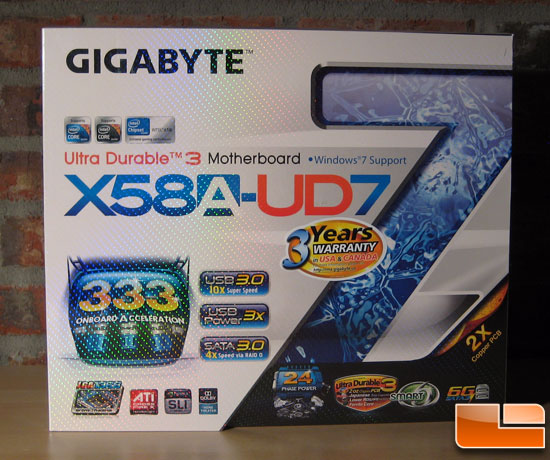Gigabyte X58A-UD7 Motherboard Review
X58 In Review
Before I started this article I was sidetracked by a brief trip to Wikipedia. The reason for this trip was the lingering feeling that the block diagram below looked excessively old. It feels like X58 and ICH10/R have been with us a bit longer than usual. Turns out X58 launched way back in November of 2008 and ICH10/R launched back in June of 2008. Since then we’ve had some evolutionary technology upgrades with USB 3.0 and SATA 6 being the most important. Where’s our ICH11R with at least SATA 6 support? Turns out we have to wait till Sandy Bridge in 2011 for a revision of either which means for now motherboard manufacturers have to turn to 3rd party solutions like Marvell’s 9128 SATA 6Gb/s controller and NEC’s D720200 USB 3.0 controller for support.

I mention all of this as today I have Gigabyte’s latest flagship X58 motherboard, the X58A-UD7. In traditional Gigabyte fashion there is an overabundance of everything on this board ranging from “24” phases for CPU power to a total of 14 available connections for SATA/PATA hard-drives. We’ll talk about the specifics later but let’s get a general look at the board now. Price is a big factor with this board with a $349.99 price tag at Newegg.com. At least they are so kind as to throw in free shipping which actually is rather nice as the box this board comes in is huge.

Next let’s consider the competition. For this I’d say any board within $40 would be eligible competition which leaves us with the MSI P55 Big Bang Trinergy and P55 Big Bang Fuzion, EVGA’s P55 Classified NF200 and X58 E760 Classified, and Asus’ X58 P6X58D Premium, X58 P6T6 WS Revolution and X58 Rampage II Extreme. All of these boards are rather nice options but none of them except the P6X58D Premium include SATA 6Gb/s or USB 3.0 support so Gigabyte gets a gold star for that. It should be noted that the Asus X58 Rampage III Extreme will be available soon with USB 3.0 and SATA 6Gb/s, but since it isn’t available it is hardly a factor. Comparing PCIe slot arrangement all these boards support 3-way SLI/CrossFire but only the $400 P6T7 WS Supercomputer supports 4-way SLI/CrossFire. This isn’t exactly a huge issue as the market for 4-way SLI/CrossFire is very small but when you are spending $350 on a motherboard you might as well have the option. Unfortunately I haven’t got an Asus Rampage II Extreme as it appears to be the ideal comparison but I do have an EVGA E760 Classified and it will offer a well enough comparison. Below for your ease of browsing I’ve included the specification sheet for the Gigabyte X58A-UD7.
| CPU |
|
| QPI |
|
| Chipset |
|
| Memory |
(Go to GIGABYTE’s website for the latest memory support list.) |
| Audio |
|
| LAN |
|
| Expansion Slots |
|
| Multi-Graphics Technology |
|
| Storage Interface | South Bridge:
Marvell 9128 chip:
GIGABYTE SATA2 chip:
JMicron JMB362 chip:
iTE IT8720 chip:
|
| USB | Integrated in the South Bridge
NEC chip:
|
| IEEE 1394 |
|
| Internal I/O Connectors |
|
| Back Panel Connectors |
|
| I/O Controller |
|
| H/W Monitoring |
|
| BIOS |
|
| Unique Features |
|
| Bundle Software |
|
| Operating System |
|
| Form Factor |
|
| Note | (Note 1) Due to Windows Vista/XP 32-bit operating system limitation, when more than 4 GB of physical memory is installed, the actual memory size displayed will be less than 4 GB. (Note 2) For optimum performance, if only one PCI Express graphics card is to be installed, be sure to install it in the PCIEX16_1 slot; if you are installing two PCI Express graphics cards, it is recommended that you install them in the PCIEX16_1 and PCIEX16_2 slots. (Note 3) The PCIEX8_1 and PCIEX8_2 slots share bandwidth with the PCIEX16_1 and PCIEX16_2 slots espectively. When PCIEX8_1 is populated with an expansion card, the PCIEX16_1 slot will operate at up to x8 mode; when PCIEX8_2 is populated with an expansion card, the PC IEX16_2 slot will operate at up to x8 mode. (Note 4) Whether the CPU/system fan speed control function is supported will depend on the CPU/ system cooler you install. (Note 5) Available functions in EasyTune may differ by motherboard model. |
| Remark |
|

Comments are closed.